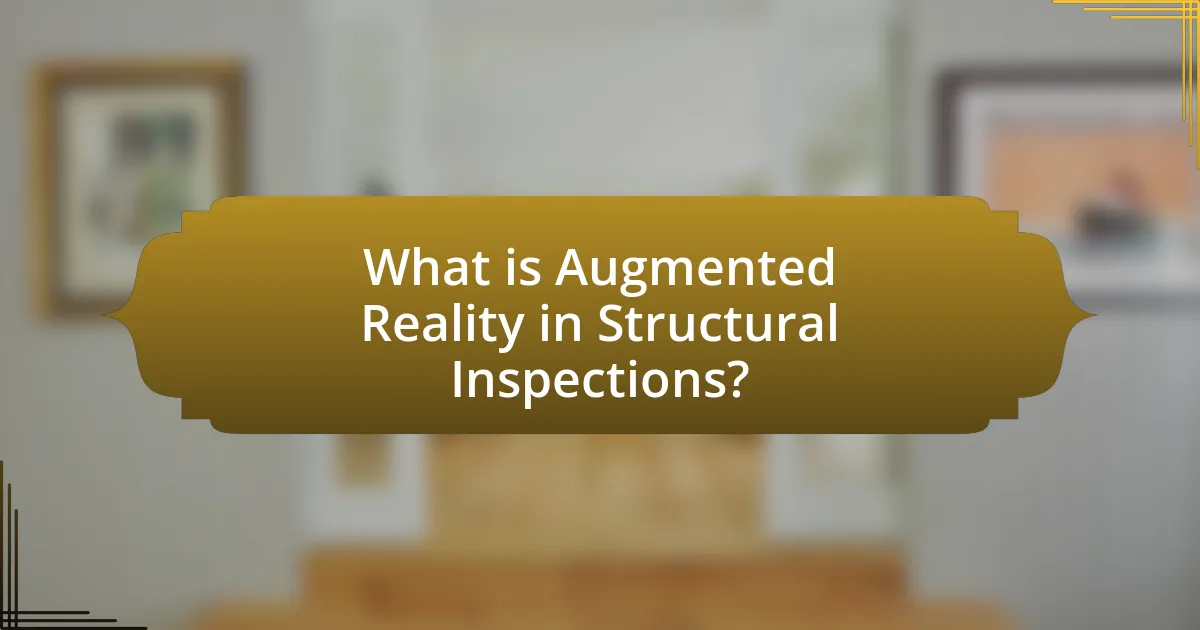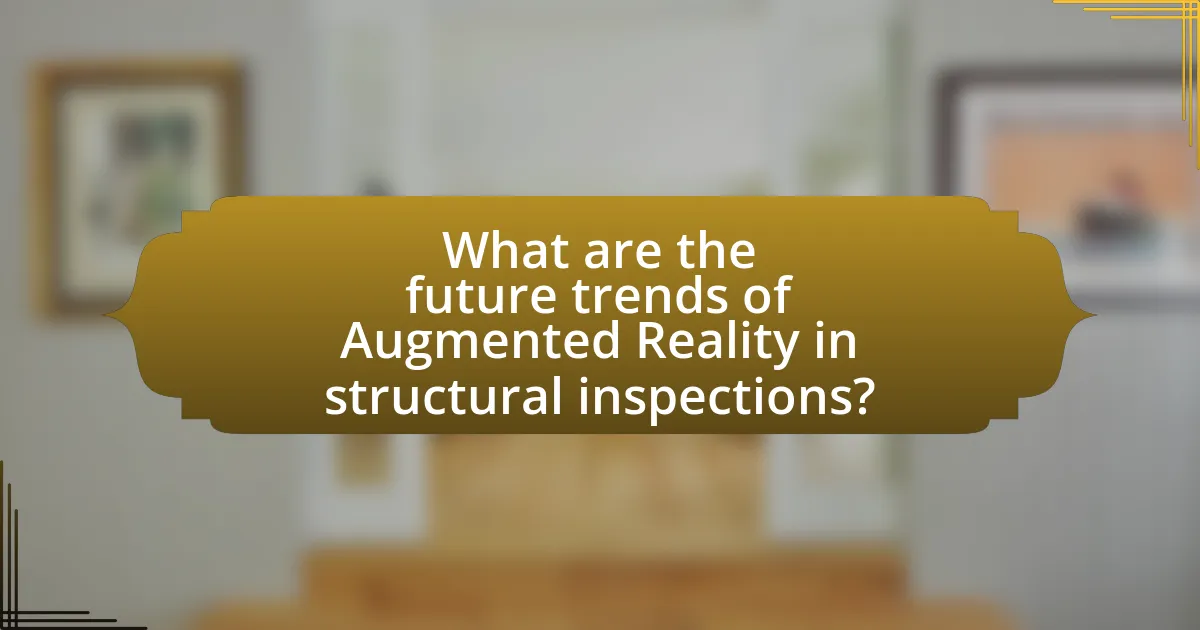Augmented Reality (AR) is a transformative technology in structural inspections, enhancing the inspection process by overlaying digital information onto physical environments. This article explores how AR improves traditional inspection methods through real-time visualization, interactive data overlays, and integration with existing tools, leading to increased accuracy and efficiency. Key benefits include reduced inspection times and enhanced defect detection, while challenges such as technical limitations, costs, and user acceptance are also addressed. The article further discusses the role of artificial intelligence in AR, future trends, and best practices for successful implementation in structural inspections.

What is Augmented Reality in Structural Inspections?
Augmented Reality (AR) in structural inspections is a technology that overlays digital information onto the physical environment to enhance the inspection process. This integration allows inspectors to visualize structural elements, identify defects, and access real-time data through devices like smartphones or AR glasses. Studies have shown that AR can improve accuracy and efficiency in inspections by providing contextual information, such as 3D models or historical data, directly in the inspector’s line of sight, thereby reducing the likelihood of oversight and enhancing decision-making.
How does Augmented Reality enhance traditional structural inspection methods?
Augmented Reality (AR) enhances traditional structural inspection methods by providing real-time visualization and interactive data overlay, which improves accuracy and efficiency. AR allows inspectors to visualize structural elements and potential issues in their actual context, facilitating better decision-making. For instance, a study published in the journal “Automation in Construction” demonstrated that AR can reduce inspection time by up to 30% while increasing the detection of structural anomalies by 25%. This integration of digital information with the physical environment enables inspectors to identify problems more effectively and communicate findings with stakeholders more clearly.
What technologies are involved in Augmented Reality for structural inspections?
Augmented Reality (AR) for structural inspections involves technologies such as computer vision, 3D modeling, GPS, and mobile devices. Computer vision enables the recognition and analysis of structural elements, while 3D modeling provides a visual representation of structures for comparison with real-world conditions. GPS technology allows for precise location tracking, ensuring that inspections are conducted accurately in the field. Mobile devices, including smartphones and tablets, serve as platforms for AR applications, facilitating real-time data overlay and interaction during inspections. These technologies collectively enhance the efficiency and accuracy of structural assessments.
How does Augmented Reality integrate with existing inspection tools?
Augmented Reality (AR) integrates with existing inspection tools by overlaying digital information onto physical environments, enhancing the inspection process. This integration allows inspectors to visualize complex data, such as structural integrity metrics, directly on the structures being assessed, improving accuracy and efficiency. For instance, AR can utilize data from traditional inspection tools like drones or thermal cameras, displaying real-time analytics and 3D models that guide inspectors in identifying issues more effectively. Studies have shown that AR can reduce inspection time by up to 30% while increasing the detection of anomalies, thereby validating its effectiveness in enhancing traditional inspection methodologies.
What are the key benefits of using Augmented Reality in structural inspections?
The key benefits of using Augmented Reality (AR) in structural inspections include enhanced visualization, improved accuracy, and increased efficiency. AR allows inspectors to overlay digital information onto physical structures, enabling them to visualize complex data in real-time. This technology improves accuracy by providing precise measurements and identifying potential issues that may not be visible to the naked eye. Additionally, AR streamlines the inspection process, reducing the time required for assessments and minimizing the risk of human error. Studies have shown that AR can decrease inspection times by up to 30%, demonstrating its effectiveness in enhancing operational efficiency.
How does Augmented Reality improve accuracy in inspections?
Augmented Reality (AR) improves accuracy in inspections by overlaying digital information onto the physical environment, allowing inspectors to visualize data in real-time. This technology enhances precision by providing detailed guidance, such as measurements and defect locations, directly on the inspected object. For instance, a study published in the Journal of Building Performance found that AR can reduce inspection errors by up to 30% by enabling inspectors to compare actual conditions with digital models. This capability ensures that discrepancies are identified and addressed promptly, leading to more reliable inspection outcomes.
What cost savings can be achieved through the use of Augmented Reality?
Augmented Reality (AR) can achieve significant cost savings in structural inspections by reducing the need for physical site visits and minimizing downtime. By utilizing AR, inspectors can visualize structures and identify issues remotely, which decreases travel expenses and time spent on-site. A study by the National Institute of Standards and Technology found that AR can reduce inspection time by up to 30%, leading to lower labor costs and increased efficiency. Additionally, AR enhances training and knowledge transfer, which can further decrease errors and associated costs in maintenance and repairs.

What challenges are associated with implementing Augmented Reality in structural inspections?
Implementing Augmented Reality (AR) in structural inspections faces several challenges, including technical limitations, high costs, and user acceptance. Technical limitations arise from the need for accurate 3D modeling and real-time data integration, which can be complex and resource-intensive. High costs are associated with the development and deployment of AR systems, including hardware and software investments. User acceptance is another significant challenge, as inspectors may be resistant to adopting new technologies due to a lack of familiarity or perceived reliability. These challenges hinder the widespread adoption of AR in structural inspections, as evidenced by studies indicating that only a fraction of construction firms have integrated AR into their processes.
What technical limitations exist for Augmented Reality applications?
Technical limitations for Augmented Reality applications include hardware constraints, software compatibility issues, and environmental factors. Hardware limitations arise from the processing power and battery life of devices, which can restrict the complexity and duration of AR experiences. For instance, mobile devices often struggle with high-resolution graphics and real-time data processing, leading to lag or reduced functionality. Software compatibility issues can occur when AR applications do not integrate seamlessly with existing systems or platforms, hindering their usability in specific contexts. Environmental factors, such as lighting conditions and physical obstructions, can also impact the effectiveness of AR, as these applications rely on accurate spatial mapping and user interaction with the real world. These limitations collectively affect the performance and reliability of AR in practical applications, including structural inspections.
How can data security concerns impact the use of Augmented Reality?
Data security concerns can significantly hinder the adoption of Augmented Reality (AR) in structural inspections by creating apprehension around the protection of sensitive information. When AR systems collect and process data related to structural integrity, they often handle proprietary designs, inspection results, and client information, which can be vulnerable to breaches. For instance, a study by the Ponemon Institute found that 60% of organizations experienced a data breach due to inadequate security measures, highlighting the risks associated with integrating AR technologies. Consequently, these concerns can lead to reluctance among companies to implement AR solutions, ultimately stifling innovation and efficiency in structural inspections.
What training is required for inspectors to effectively use Augmented Reality?
Inspectors require specialized training in Augmented Reality (AR) technology, including software operation, hardware handling, and data interpretation. This training typically encompasses understanding AR applications relevant to structural inspections, such as 3D modeling and visualization techniques. Additionally, inspectors must learn to integrate AR with existing inspection protocols and safety standards. Evidence from industry reports indicates that effective AR training enhances inspectors’ ability to identify structural issues more accurately and efficiently, leading to improved safety outcomes and reduced inspection times.
How can organizations overcome barriers to adopting Augmented Reality?
Organizations can overcome barriers to adopting Augmented Reality (AR) by investing in training and education for employees, ensuring they understand the technology’s benefits and applications. Research indicates that a lack of knowledge and skills is a significant barrier; therefore, comprehensive training programs can enhance user confidence and competence. Additionally, organizations should conduct pilot projects to demonstrate AR’s effectiveness in structural inspections, which can help in gaining stakeholder buy-in and showcasing tangible results. According to a study by the International Journal of Advanced Manufacturing Technology, companies that implemented AR in pilot programs reported a 30% increase in efficiency during inspections, reinforcing the value of practical experience in overcoming resistance to new technologies.
What strategies can be employed to facilitate the integration of Augmented Reality?
To facilitate the integration of Augmented Reality (AR) in structural inspections, organizations can employ strategies such as developing user-friendly interfaces, providing comprehensive training programs, and ensuring robust hardware and software compatibility. User-friendly interfaces enhance accessibility, allowing inspectors to easily navigate AR applications, which is crucial for effective implementation. Comprehensive training programs equip personnel with the necessary skills to utilize AR tools effectively, as evidenced by studies showing that training increases user confidence and proficiency. Additionally, ensuring compatibility between AR systems and existing inspection technologies minimizes disruptions and promotes seamless integration, as highlighted by industry reports indicating that compatibility issues can hinder AR adoption.
How can stakeholders be convinced of the value of Augmented Reality in inspections?
Stakeholders can be convinced of the value of Augmented Reality (AR) in inspections by demonstrating its ability to enhance efficiency, accuracy, and safety during the inspection process. AR technology allows inspectors to visualize complex data in real-time, overlaying digital information onto physical structures, which significantly reduces the time required for inspections and minimizes human error. For instance, a study by the National Institute of Standards and Technology found that AR can improve inspection efficiency by up to 30% and reduce errors by 50% in construction projects. By presenting these quantifiable benefits, stakeholders can clearly see the return on investment and operational advantages of integrating AR into their inspection protocols.

What are the future trends of Augmented Reality in structural inspections?
The future trends of Augmented Reality (AR) in structural inspections include enhanced real-time data visualization, improved collaboration among teams, and increased integration with artificial intelligence. Enhanced real-time data visualization allows inspectors to overlay digital information onto physical structures, facilitating immediate identification of issues. Improved collaboration is achieved through shared AR experiences, enabling remote experts to guide on-site personnel effectively. Increased integration with artificial intelligence will enable predictive maintenance by analyzing structural data and identifying potential failures before they occur. These trends are supported by advancements in AR technology, such as the development of more sophisticated AR devices and software that enhance user experience and data accuracy.
How is the technology expected to evolve in the coming years?
Augmented reality (AR) technology is expected to evolve significantly in the coming years, particularly in the field of structural inspections. Advancements in AR will likely include improved hardware, such as lighter and more powerful headsets, which will enhance user experience and accessibility. Additionally, software developments will focus on integrating artificial intelligence to provide real-time data analysis and predictive maintenance insights during inspections. According to a report by MarketsandMarkets, the AR market is projected to grow from $18.8 billion in 2020 to $198.17 billion by 2025, indicating a robust trend towards widespread adoption and innovation in AR applications, including structural inspections.
What role will artificial intelligence play in enhancing Augmented Reality for inspections?
Artificial intelligence will significantly enhance Augmented Reality (AR) for inspections by improving data analysis, object recognition, and real-time decision-making. AI algorithms can analyze vast amounts of inspection data quickly, allowing for the identification of structural issues that may not be visible to the naked eye. For instance, machine learning models can be trained to recognize patterns in structural anomalies, enabling inspectors to focus on critical areas that require attention. Additionally, AI can facilitate real-time feedback by overlaying relevant data and insights directly onto the AR interface, thus streamlining the inspection process and increasing accuracy. This integration of AI and AR has been shown to reduce inspection times by up to 30%, as reported in studies on smart inspection technologies.
How might regulatory changes impact the adoption of Augmented Reality?
Regulatory changes can significantly impact the adoption of Augmented Reality (AR) by establishing guidelines that either facilitate or hinder its integration into industries like structural inspections. For instance, regulations that promote safety standards and data privacy can encourage companies to adopt AR technologies, as they provide a clear framework for compliance. Conversely, stringent regulations that impose heavy compliance costs or limit the use of AR in certain contexts may deter organizations from implementing these technologies. Historical examples include the introduction of data protection laws, such as the General Data Protection Regulation (GDPR) in Europe, which has influenced how companies deploy AR solutions that collect and process personal data.
What best practices should be followed when implementing Augmented Reality in structural inspections?
Best practices for implementing Augmented Reality (AR) in structural inspections include ensuring high-quality data integration, providing user-friendly interfaces, and conducting thorough training for inspectors. High-quality data integration allows AR systems to overlay accurate structural information onto real-world views, enhancing inspection accuracy. User-friendly interfaces facilitate ease of use, enabling inspectors to navigate AR tools effectively without extensive technical knowledge. Thorough training ensures that inspectors are proficient in using AR technology, which has been shown to improve inspection efficiency and reduce errors, as evidenced by studies indicating that AR can increase productivity by up to 30% in construction-related tasks.
How can organizations ensure successful training and adoption of Augmented Reality tools?
Organizations can ensure successful training and adoption of Augmented Reality (AR) tools by implementing a structured training program that includes hands-on experience, clear objectives, and ongoing support. A study by the International Journal of Human-Computer Interaction found that practical training significantly enhances user confidence and proficiency with new technologies. Additionally, organizations should involve end-users in the development process to tailor the AR tools to their specific needs, which increases acceptance and usability. Regular feedback loops and updates based on user experiences can further facilitate effective adoption, as highlighted in research from the Journal of Augmented and Virtual Reality.
What metrics should be used to evaluate the effectiveness of Augmented Reality in inspections?
The metrics used to evaluate the effectiveness of Augmented Reality (AR) in inspections include accuracy, efficiency, user satisfaction, and cost-effectiveness. Accuracy measures how well AR technology identifies and presents inspection data compared to traditional methods, often quantified through error rates or detection rates. Efficiency assesses the time taken to complete inspections using AR versus conventional techniques, typically expressed in time savings or productivity improvements. User satisfaction gauges the experience of inspectors using AR, often collected through surveys or feedback mechanisms. Cost-effectiveness evaluates the financial implications of implementing AR, comparing the costs of AR solutions against the savings generated from improved inspection processes. These metrics provide a comprehensive framework for assessing AR’s impact on structural inspections.

Leave a Reply